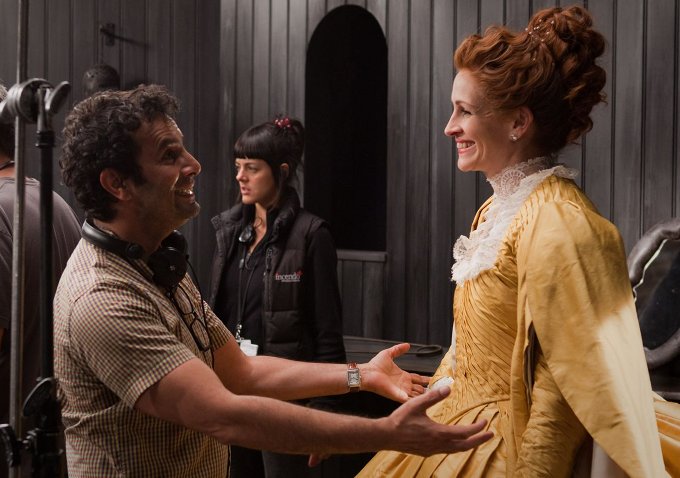 A lot has been made of the rivalry between "Mirror Mirror" and "Snow White and the Huntsman" — exemplified by the chicken-race with release dates. Before "Mirror Mirror" director Tarsem Singh could even start shooting, he told The Playlist he knew that his film had to be the first to hit theaters, "because we couldn't afford to be second."
A lot has been made of the rivalry between "Mirror Mirror" and "Snow White and the Huntsman" — exemplified by the chicken-race with release dates. Before "Mirror Mirror" director Tarsem Singh could even start shooting, he told The Playlist he knew that his film had to be the first to hit theaters, "because we couldn't afford to be second."
"Ours is the smaller film," he said. "They're much bigger financially. They have the bigger stars. We have Julia Roberts, but they have more stars."
When Singh was first offered the gig to direct a Snow White movie, he assumed Relativity wanted him to bring out the fairy tale's darker aspects (early versions hint at necrophilia, rape, and child abuse, since Snow was seven when events occurred). "Plus, way before there was a stepmother in the story, it was her mother doing this to her," Singh said. "And then her mother dies by dancing in the hot iron shoes. Try getting that a PG rating today!"
Despite the dark imagery in his previous films "The Cell" and "Immortals," Singh said he wasn't interested in going for an R-rated Snow White. "Everyone thinks I would, because that's in my DNA, but I said, 'Why are you even calling me?' " he recalled. "I wasn't interested in just doing the 'grown-up' version. 'Snow White and the Huntsman,' they can do more action-adventure, they can go for the R. I wanted to do the family-friendly version. So once they told me they were okay with doing a more accessible story, then I was interested."
Singh thought the movie should work on multiple levels, something for both kids and grown-ups. He hadn't seen the classic Disney version from 1937 — he said he purposely stayed away from it until "Mirror Mirror" was locked — but he wanted to draw upon elements that had existed in various incarnations of the fairytale over the years, such as the dwarves becoming bandits.
"The story's been rewritten in every culture," Singh said. "And it changes every five decades, based on every culture defining what's acceptable or not. I wish I could have had it be the mother instead of the evil stepmother, because there are many lovely stepmothers out there, but there's only so much you can change."
Because the budget was limited, Singh decided against shooting in 3D or doing a 3D conversion, because it would cost valuable time. "We were originally thinking of doing this in 3D," he said, "but when the moment came to make the decision, I knew it would cost us at least another three months." Three months, if it were rushed — "Immortals" required a year of 3D conversion, and he didn't want to hurry on this part of the process, even if he had to hurry elsewhere. "I didn't want to compromise on quality. So we lost the 3D."
Singh also chose to shoot in Montreal based on cost and practicality. He couldn't afford to travel with his cast and crew to multiple locations, "since we had so little time to make it," so he wanted everything in one space. His team found a big stage where he could have "all the facilities in one building: art, post, studio, all in 20 feet of walking distance. That's why Montreal won."
Racing to the finish line had its advantages — shaving off time on one end bought it on another. Singh had allotted himself ten weeks to shoot, and was surprised when he came in under time, finishing and locking the film at the six-and-a-half week mark. "I think it was that I just knew what I wanted," he said. "I knew what I wanted, Julia knew what she wanted, and having someone like Julia on set, nothing was questioned. I was very happy, because I got what I needed, and I finished much earlier than I expected. Of course, we couldn't release it any earlier, but at least we weren't scrambling to get it out!"
Singh said he's happy with how his Snow White turned out, especially because it's "not the same classic story" everyone thinks they know. "When kids see the apple, they gasp," he laughed. "But it's not just for kiddies."
"Mirror Mirror" opens on March 30th.

